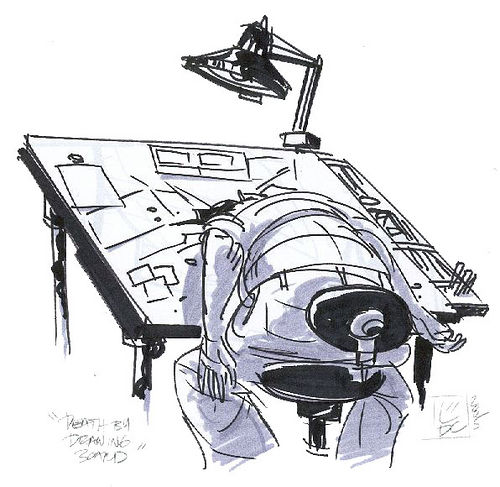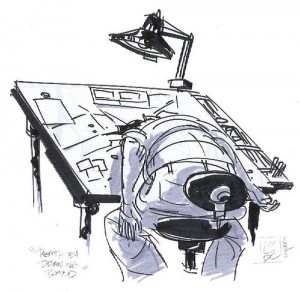
The diesel fumes that are causing health impacts to workers and residents are coming from the “diesel blanket” that is injected into the salt dome to prevent leaching. Yeah, that’s right folks, another example of Legal but Stupid.
I’m just going to go out on a limb here to say that diesel should never be allowed on, in or near the ground. If you can’t figure out a better way than injecting diesel into the earth, —–>
Here is an explanation:
The diesel odor and residual diesel material is coming from the diesel blanket from the Texas Brine cavern that was plugged in 2011.
When you construct and operate a salt solution mining cavern, you inject diesel to serve as a blanket. It protects the upper portion of the leaching cavern from degradation in the area where the casing extends from the ceiling of the cavern. When the cavern is no longer used, it remains filled with brine for stability and the diesel blanket continues to float at the top of the cavern.
Natural gas was stored in a caverns on either side of the cavern that is collapsing. Because there is porosity in the materials making up this dome, migration is possible and or likely.
I will have more information from this source tomorrow.
Also see: Breaking: Huge sinkhole in Louisiana over natural gas storage area. And UPDATE 2.
Sorry, I forgot this part:
The bubbling is not from the diesel. The bubbles were tested and they were methane bubbles. Some sources are saying the methane is naturally occurring but… Stay tuned.
About Sharon Wilson
Sharon Wilson is considered a leading citizen expert on the impacts of shale oil and gas extraction. She is the go-to person whether it’s top EPA officials from D.C., national and international news networks, or residents facing the shock of eminent domain and the devastating environmental effects of natural gas development in their backyards.
- Web |
- More Posts(5121)
Thanks Sharon for the update…..U R really Super Sharon only your Batgirl mask is a respirator huh?
Thanks. We are all super in our “all hands on deck” approach.
Thanks so much for this update!
I’ve been involved in natural gas storage in salt caverns, and thought I’d mention a couple of things:
1) The diesel blanket is used during the cavern leaching process, early on when fresh water is introduced into the cavern to leach out the “hole” or cavern in the salt that will eventually be used to store gas in. As mentioned by others, the diesel floats on top of the brine in the cavern and prevents leaching of the “roof” of the cavern where the well casing strings are cemented in. The main point I wanted to make is that this diesel is generally removed when the cavern is converted to gas storage use, as it no longer serves any purpose (the gas serves that purpose from that point forward if there is any leaching still going on, which there usually isn’t).
2. The reason that companies store gas in salt domes is that, generally speaking, salt does NOT have much porosity / permiability and gas does NOT leak through it. Also, the salt actually acts like a very viscous fluid in that it “creeps” or flows very slowly in response to stress or differential pressure. What this means is that you usually will not see cracks in a salt dome; they flow to relieve any such stresses. As an aside, that’s why the oil companies first started looking for oil and gas in fault traps sealed against the salt dome flanks – the faults wouldn’t continue on through the salt dome. However, some salt domes have a certain amount of gas held in their matrix that is released when the salt is dissolved. Typically, these salts are lower in strength, which can affect the minimum pressure you operate the cavern at.
3. I wonder a bit at drawing down the pressure in the cavern, as that lower pressure would seem to me to increase the differential pressure across the cavern wall (from the naturally occuring lithostatic pressure of approx. 1 psi per foot of depth minus whatever pressure they are reducing the cavern pressure to). The lower the cavern pressure, the greater the “collapsing pressure” across the cavern wall.
4. Still, if there is a gas leak, then there must be a novel situation such as a “too thin” web between this cavern and the side of the dome, or to another cavern with a path to the surface.
5. The fact of the subsidence is disturbing to me. I have seen caverns shrink over time due to “creep”, but most of that was from the bottom coming up or the sides peeling off and falling to the bottom, like an onion skin, and NOT from a roof fall. That is, nothing that would show a surface impact. A roof fall would not be good, because that could threaten the integrity of the casing strings. Also, if the thickness of the overhead salt wasn’t very high and you had a roof fall, I guess you could potentially breach the top of the salt dome with your cave-in, which would expose more-normal (permiable) strata to the high-pressure gas, which could then find a leak path vertically or horizontally away from the cavern.
6. They haven’t said how much gas is in this individual cavern, and if there are other caverns immediately adjacent to it. The only good news here is that it is gas, which should dissipate without causing too much pollution, so long as it comes out in a remote area. And it is a finite amount (unlike a producing well, say), and they are reducing that amount by reducing the pressure on the cavern until they know beter what’s going on.
Sorry, your comment was stuck in the spam folder. That happens sometimes and most of the time I delete all spam without checking.